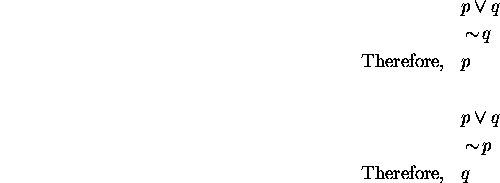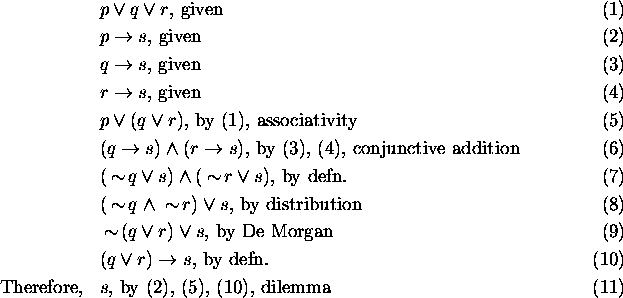Valid and Invalid Arguments
Tom Kelliher, MA 115
Sept. 17, 1997
Quiz on Friday:
- 10--15 minutes.
- One problem from Section 1.1 and one problem from Section 1.2.
- You may bring one
 two-sided sheet of notes.
two-sided sheet of notes.
- The following problems from Section 1.3 are due Monday: 11, 28, 29,
37.b.
- Friday, we will discuss material from Sections 1.4 and 1.5, but you
will not be responsible for it.
- What did we say constituted a valid argument?
- Can one mechanically check that an argument form is valid?
- What is an argument form?
In class, we'll only hit the ``highlights'' of the following.
Method by affirming:

Remember: p is a sufficient condition.
Method by denying:

Use the contrapositive to see similarity to Modus Ponens.
Generalization:

Would it be valid to go the other way?
Simplification:



Process of elimination.

Remind anyone of transitivity?

Can this be generalized to more cases?
Generalize to three cases:


where c is a contradiction.
How can we prove the previous forms, again?

Not!

Again, Not!
- The famous detective Percule Hoirot was called in to solve a baffling
murder mystery. He determined the following facts:
- Lord Hazelton, the murdered man, was killed by a blow on the head
with a brass candlestick.
- Either Lady Hazelton or a maid, Sara, was in the dining room at
the time of the murder.
- If the cook was in the kitchen at the time of the murder, then the
butler killed Lord Hazelton with a fatal dose of strychnine.
- If Lady Hazelton was in the dining room at the time of the murder,
then the chauffeur killed Lord Hazelton.
- If the cook was not in the kitchen at the time of the murder, then
Sara was not in the dining room when the murder was committed.
- If Sara was in the dining room at the time the murder was
committed, then the wine steward killed Lord Hazelton.
Who was the murderer?
- Sharky, a leader of the underworld, was killed by one of his own band
of four henchmen. Detective Sharp interviewed the men and determined that
all were lying except for one. He deduced who killed Sharky on the basis of
the following statements:
- Socko: Lefty killed Sharky.
- Fats: Muscles didn't kill Sharky.
- Lefty: Muscles was shooting craps with Socko when Sharky was
knocked off.
- Muscles: Lefty didn't kill Sharky.
Who killed Sharky?
Work in groups of two on the following problems from the end of
Section 1.3: 3, 6, 35, 36.
Thomas P. Kelliher
Tue Sep 16 11:25:46 EDT 1997
Tom Kelliher
 two-sided sheet of notes.
two-sided sheet of notes.
 two-sided sheet of notes.
two-sided sheet of notes.











